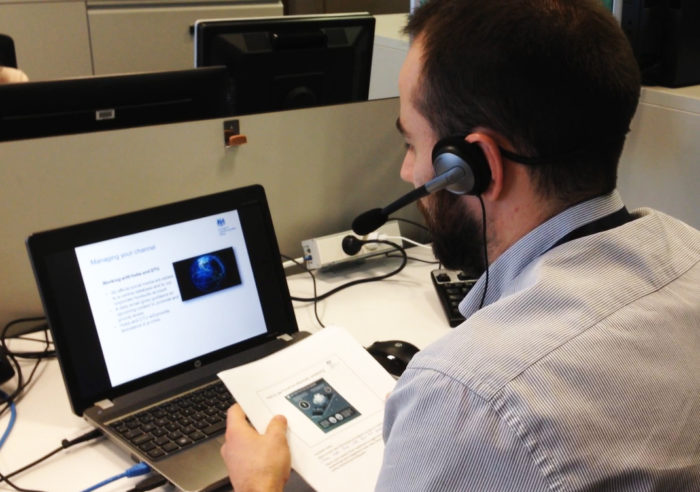26th May 2016
Remote Training: Is there anybody out there?

I´ve been Europe’s Regional Digital Training Officer for six months, training over the phone and on a shared desktop (where bandwidth allows). Previously, I worked as a teacher in a high school, so remote training is almost completely new to me. I’ve discovered that in many ways it is more difficult than attempting to control 35 rowdy teenagers in a classroom. While I no longer have to shout so much, it comes with its own set of unique challenges!

To deliver training remotely, we use a screen-sharing programme called Join.Me that allows participants from any of the European and Central Asian embassies and delegations we support to connect to my screen as well as audio. When I delivered my first session, I was surprised to find that the main challenge was not remembering the content, but trying to deal with the lack of interaction in the remote environment.
Elephants (or rather trainees) are not in the room
Many of the group activities that are intended for face-to-face training can´t be done remotely. Replacing these activities with the trainer´s explanation is not as effective or as engaging as working with delegates in the flesh. Interaction goes down even more when you have 14 people all on a call at once, some of whom are working in busy offices and need to mute their phones (but unmute for any questions of course) to minimize background noise and feedback. This strange dynamic sometimes puts people off speaking at all, even when there is a discussion or question and answer session in the training. It sometimes seems that the more people on the call, the more reluctant people are to participate.

On the other hand, we seem to get higher levels of interaction during smaller training sessions which the team has run. Tim Colley, the future Ambassador to Latvia commented on the differences:
“The large group worked surprisingly well but must have been challenging for the presenter as it is almost a monologue with little of the natural feedback that comes in face-to-face interaction. The 1:1 was much more interactive and hence tailored to my questions and needs.”
Ewan’s top tips for remote training
I´ve found the interaction issue does have an impact on the training, so here are my top tips to get people talking and interacting more in the remote environment:
- Introductions at the start of the call to break the ice and increase verbal participation
- Sending pre- and post-engagement activities for attendees before and after the sessions which relate to the training module
- Having segments where I can speak and the participants can type comments and questions in the chat space on the shared desktop
- Implementing a mandatory slot at the end of each session for discussion and questions
- Organising post-training group discussions using video conferencing where people can speak about a planned activity, or raise concerns they have
Replacing the human contact you get with face-to-face training is clearly a big challenge but I remain hopeful that the changes I´m implementing will go some way towards addressing this. I´m also confident that as technology improves, so will our ability to train remotely.
Despite the challenges of remote training we have achieved a lot. In Europe alone we have trained a remarkable 99 people remotely since the digital curriculum was introduced in 2014. Through using digital applications such as screen-sharing apps, I can train 14 people (or more) across the network all at the same time. Liz Hitchcock, Training Manager for the FCO’s Digital Transformation Unit (DTU), praises the use of collaborative technology:
“The DTU sets a great standard in using Google Drive and Join.Me webinar technology – we hope to see this used more broadly for collaboration and communication around the whole FCO network as soon as possible.”
Last week Liz Hitchcock also blogged about a new digital offer for leadership at posts. We support digital credibility at posts by offering one-to-one support and advice, and also through our ongoing training modules.
From course feedback it´s clear that our efforts and investment in remote training are being well received and resulting in a more effective use of digital by the network. The next step is to put into practice some of the ideas I´ve been trying out and make our remote training courses better adapted to the experience we get when training face-to-face. Addressing the interaction issue has been, and will continue to be, challenging work. So far though, there´s certainly been a lot less shouting!
